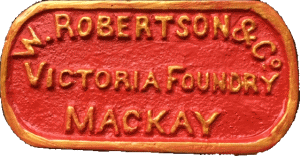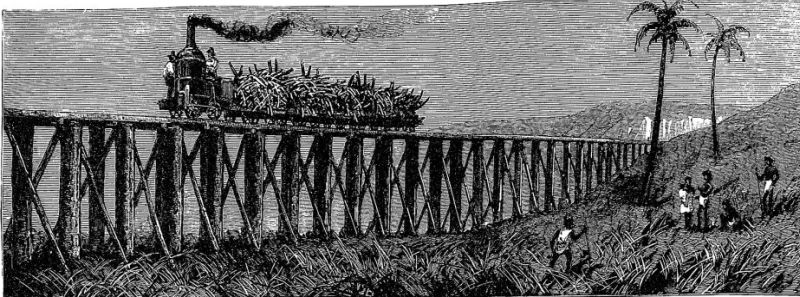



| Year Built | 1880 |
| Builder | Victoria Foundry (Mackay, Queensland) |
| Works Number | Unknown |
| Wheel Type | 0-4-0VBT |
| Cylinders | 2VC |
| Mill First Used at in Mackay | Pioneer/River Estate |
| ID Number or Name | "MARY ANN" |
| Fate | Unknown possibly Scrapped |
| History
This was the first Steam Locomotive in the Mackay district and was made by Robertson and Co's, Victoria Foundry in Mackay. It was delivered on in May 1880. It was used at both of Spiller's Estates, Pioneer and River Estate to haul cane to the mills. It had a vertical boiler and was based on a 3 feet 6 inch gauge. John Spiller started the first Sugar Plantation in the Mackay district in 1867. In 1879 he decided to construct portable tramlines to get the cane to the mills of Pioneer and River Estate. A description of the Cane railway was given in the edition of the "Mackay Mercury and South Kennedy Advertiser" of 1 September 1880. After partaking of a substantial repast, the sound of the whistle of the locomotive warned us to prepare for a contemplated trip through the cane fields. We had the advantage of the company of two ladies who honoured us on the occasion. A little distance from the manager's home, and close to the mill, is the terminus. Here we found the iron horse blowing off his steam and impatient for the journey. Having taken our seats in a first class carriage, which by the bye, consisted of a cane truck with sacks full of cane chaff for seats, our driver, Mr. Crees, gave the two or three preliminary whistles en regale and we were off. To describe the line of railway is but to ask my Southern readers to realise what they pass over on the Southern and Western lines. The one in question is just as well laid, and as free from "bumps." The engineer of the estate, Mr. Braby constructed the whole work, and it is only fair to say of that gentleman, that it is a credit to him. The first part of the line describes a sharp curve which leads to a decline, at the bottom of which there is a viaduct of wood, which in some places is as much as twenty feet high from the level of the ground below. All this is constructed of piles driven into the ground and braced firmly together. At the top of a stiff incline we came to a cutting which extends for several hundred yards. Thence the line runs in a straight direction for about a mile and a half, to a spot which must have taxed the energies of the engineer. This consists of a swamp under which is a stiff black loamy soil. Sometimes, I was informed, there is as much as two feet of water surrounding this part of the line. This swamp is at present being drained into a creek which is in the course of formation, and it is evidently only a question of time, as to when the whole of the neighbouring land will be brought into cultivation. Here we gave our horse water. This was done by dipping buckets and banding them from one to another, till the last man emptied his bucket into the tank of the engine, causing a considerable delay. After taking in a supply of water, our amateur driver took us at a rattling pace to where the canes were being cut for immediate crushing. Here the scene was busy enough. Numbers of Kanakas were employed, some in cutting, others in carting to the down tramway, and. another contingent in packing the cane on the trucks, The scene was most un-English and indeed entirely tropical. The men looked up as we passed, but with that stolidity which characterises the semi-savage, and work was again steadily resumed. The train runs five trips a day at present, and brings up at each trip what would amount to from sixteen to twenty loads. This must be an immense saving, indeed I was informed, it amounts to the difference between £300 and £60 for haulage alone, besides being able to work when the ordinary roads are bad. On each side of the line the land, with small intervals, is under cane as far as the eye can reach, some ready for crushing, some coming on for next year's harvest, and some just sprouting from the ground. To give an idea of the operations, as to their magnitude, I was shown a nice little piece of land, say of about 300 acres. About four months ago it was ordinary bush ; now it is all under cane which is looking exceedingly well. In order to bring it into cultivation as many as a dozen ploughs might have been seen day after day, one following the other; while an army of South Sea Island labourers were busy with the hoe. As we arrived at the down terminus, which I should have stated, is something more than three miles from the mill, the return trucks were already loaded, which, having coupled, we again started for home. The line running through the centre of the estate must be a great boon to the spirited proprietor, but it is patent that it will be here- after necessary to make a portable railway that can be easily laid down and taken up, to connect the fields laterally with the trunk line. The engine, which performed its work well, was constructed by Mr. Robertson, of the Victoria Foundry, Mackay. She runs along with great ease, and performs the distance in a very short time, say about at the rate of eight or nine miles an hour. There was only one attempt at a jib, as we were returning up a steep pinch. The engineer attributed the partial stoppage to an extra load of cane, put on in honour of our visit, but I knew very well better. I had only to glance at tho occupants of the "First-class carriage," and the suggestion forced itself upon the mind, that it was not often that that engine was called upon to draw such men of weight. Modesty, how- ever, commanded silence. It is only fair to say, though, that the writer got off for a moment, when, hi presto ! he had only time to "catch the train."
|
|
| References | 1880
'THE SUGAR PLANTATIONS OF THE PIONEER.', Mackay
Mercury and South Kennedy Advertiser (Qld. : 1867 - 1887),
1 September, p. 2. , viewed 19 Aug 2018, http://nla.gov.au/nla.news-article169522403
Manning, K., 1983, In Their Own Hands, Farleigh Co-Operative Sugar Milling Association Ltd. Farleigh , QLD. Browning, John. various emails. |
 |
|
John Spiller's first Loco 1880 (Original photo of John Henry Mills) |
 |
| Lithograph from "The Graphic", 27 January 1883. |